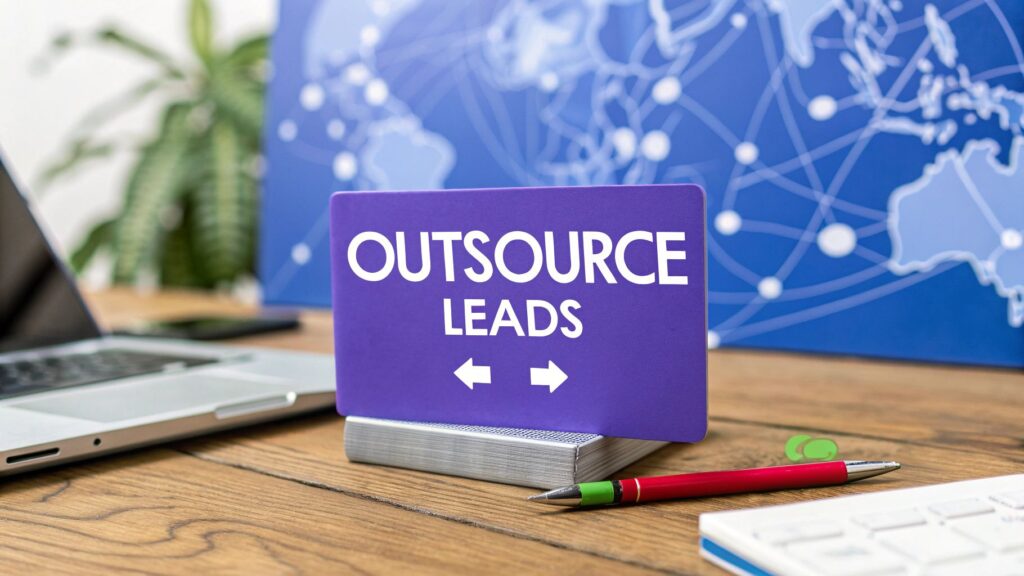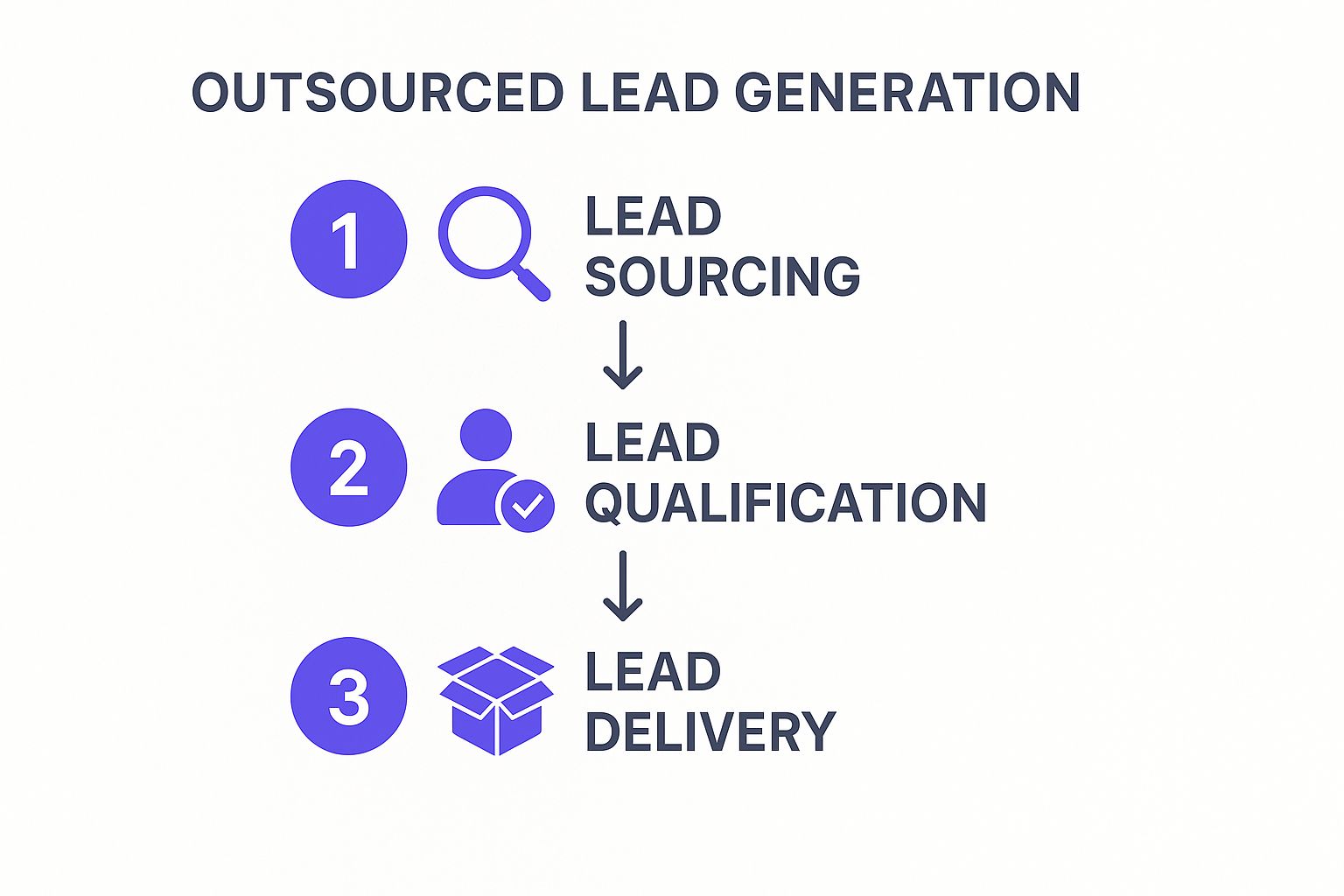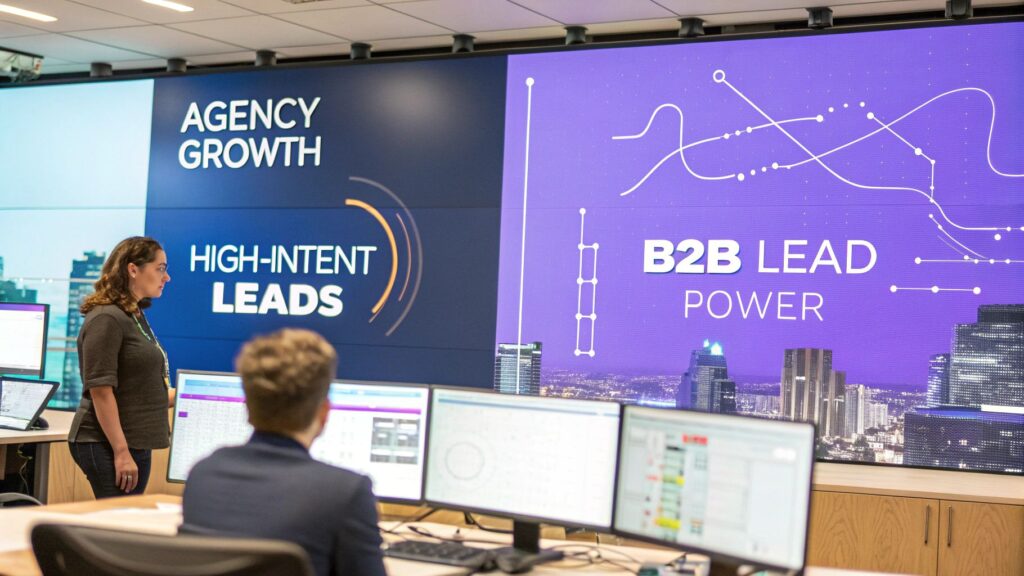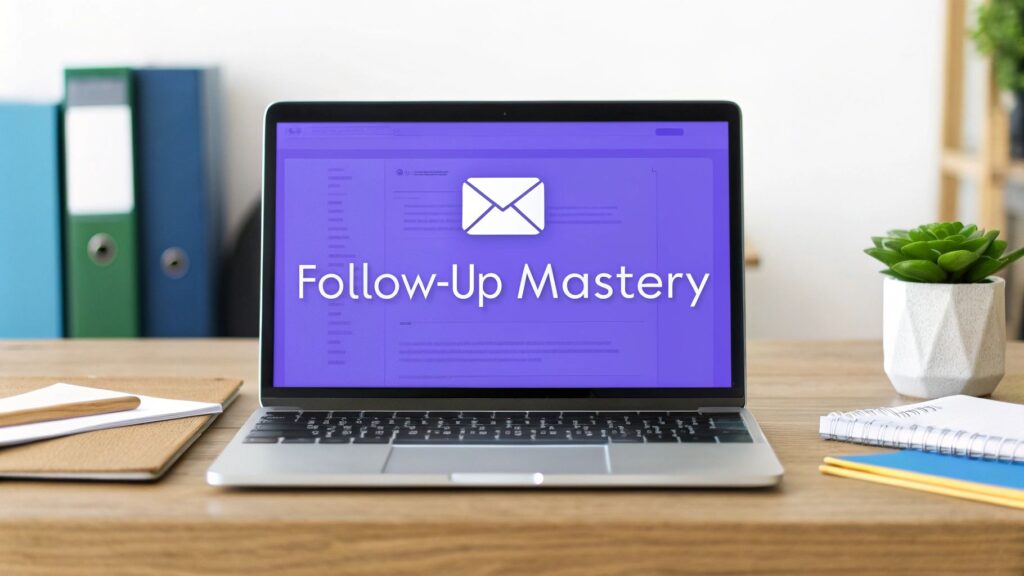Agency Growth Through Outsourced Lead Generation

When an agency decides to outsource its lead generation, it's essentially handing over the keys to its client acquisition engine to a specialized partner. This isn't just about finding someone to make cold calls; it's a strategic decision to have an external team manage the entire process, from finding potential clients to qualifying them for a sales conversation. The goal is to move from a rigid, in-house cost structure to a flexible approach focused purely on building a consistent sales pipeline.
Why Smart Agencies Outsource Lead Generation
Every agency owner knows the "feast or famine" cycle. One quarter you’re buried in client work, and the next, you’re desperately trying to land new projects just to keep the lights on. That revenue rollercoaster makes it incredibly difficult to forecast growth, manage cash flow, or scale the team with any real confidence.
Outsourcing lead generation is the most direct way to solve this fundamental problem. It’s designed to create a steady, predictable flow of new business opportunities, month after month. This isn't just about offloading a task you don't like; it's a strategic move to build a more stable, scalable business.
The True Cost of In-House Teams
Putting together an in-house sales team is a far bigger investment than just salaries. A single Business Development Representative (BDR) can cost over $75,000 per year in salary alone, not including commissions. Think about the hidden costs: recruitment agency fees (often 15-20% of the first year's salary), weeks of training, benefits packages, and the pricey tech stack needed to do the job right. We're talking CRMs, data enrichment tools, and sales automation software—which can easily add another $500-$1,000 per month per rep.
For most agencies, these fixed overheads can be a massive financial burden, especially when the results aren't guaranteed. It can take a new BDR 6-9 months just to become fully productive.
When you outsource, you transform those heavy fixed costs into a much more manageable variable expense. Instead of being locked into a full-time salary, you might engage a partner on a flexible monthly retainer. For a fraction of the cost of one full-time employee, you gain access to an entire team and their established processes. This gives you way more agility and is often far more cost-effective. To get a better handle on the basics, it's always a good idea to review the general principles of lead generation.
Gaining a Competitive Edge
Picture a small creative agency. Their team is brilliant at design and brand strategy, but they just don't have the time or the specific skillset for consistent B2B prospecting. They decide to partner with an outsourced firm that knows their niche inside and out. For example, they might partner with a firm that specializes in generating leads in the e-commerce CPG space.
Suddenly, they don't just have a few people making calls. They have a team of seasoned pros, plus access to advanced intent data platforms (like Bombora or 6sense) and AI-powered prospecting tools—tech that would have been completely out of reach for them to buy on their own.
The real advantage of outsourcing is gaining immediate access to a specialized machine built for one purpose: finding your next client. You're not just hiring people; you're plugging into a proven system.
This move lets the agency's core team get back to what they do best—delivering amazing creative work for clients. Meanwhile, the partner is busy filling the top of their sales funnel.
Within a few months, the agency has a predictable stream of qualified meetings on the calendar. This stabilizes their revenue and gives them the confidence they need to finally hire that new designer they've been wanting. Ultimately, exploring expert partnerships is a critical component of modern lead generation for agencies. To dive deeper into how specialized firms are driving growth, check out our full guide on lead generation for agencies.
Are You Really Ready to Outsource Your Lead Gen?
Jumping into a partnership with a lead generation firm before you've taken a hard look in the mirror is a classic mistake. I’ve seen it happen time and again. Agencies get excited about the promise of a full calendar, sign a contract, and then wonder why it’s not working.
Before you even think about talking to a provider, you need a crystal-clear picture of your own operations. This isn't just about avoiding a bad investment; it's about setting up any future partnership for actual success.

Outsourcing can't fix a problem you haven't defined. If you throw money at an external team without this internal clarity, you're just paying someone else to fail on your behalf.
What's Your Real Cost Per Lead?
First things first, you have to know your numbers. What is it truly costing you to land one qualified lead right now? Most agency owners I talk to seriously underestimate this because they only count the obvious stuff, like ad spend.
To get the real number, you have to dig deeper and include everything:
- Salaries: What percentage of your team's time is spent prospecting, going to networking events, or on other sales-related tasks? If a founder earning $150k/year spends 20% of their time on sales, that's a $30,000 annual cost right there.
- Software Stack: Add up the monthly costs for your CRM, email automation tools like Mailchimp or HubSpot, and any other sales tech you use.
- Campaign Costs: This is the budget for your ads, content creation, lead magnets—the works.
- Opportunity Cost: This one is huge. What could your team be doing—like client work or strategic planning—if they weren't chasing down leads? If that founder's time is worth $200/hour in billable work, that $30,000 in sales time is actually a $96,000 opportunity cost.
Once you have an honest Cost Per Lead (CPL), you’ve got your benchmark. It’s the only way to look at a proposal from a potential partner and know for sure if they’re offering you a good deal.
Nail Down Your Ideal Customer Profile (ICP)
Here's the single biggest reason outsourced campaigns fall flat: a vague, poorly defined target audience. You simply can't hire an outside team to find your dream clients if you can’t describe them with excruciating detail. A rock-solid Ideal Customer Profile (ICP) is absolutely non-negotiable.
I once worked with a web development agency that learned this the hard way. They rushed into an agreement and told their new partner to find "tech companies." What did they get? A firehose of leads from tiny, pre-revenue startups that had no budget for their high-end services.
Their mistake is a perfect lesson. A weak ICP doesn't just get you a few bad leads; it guarantees that almost all your leads will be poor quality. The partner did exactly what they were asked, but the agency had aimed them at the wrong galaxy.
Your ICP needs to be a living document, not just a gut feeling. It should cover:
- Firmographics: Industry (e.g., B2B SaaS, not just "tech"), specific company size (e.g., 50-200 employees), annual revenue (e.g., $10M-$50M ARR), and geographic location.
- Technographics: What specific software, platforms, or tech stacks do they use? (e.g., "Companies using HubSpot Marketing Hub and Salesforce CRM.")
- Pain Points: What are the precise business problems that your agency is uniquely qualified to solve? (e.g., "Struggling to generate MQLs from their content marketing efforts despite high traffic.")
- Buying Signals: Are they hiring for a specific role (e.g., "VP of Marketing")? Did they just receive funding? Is a key executive new to the team?
This level of detail turns your ICP into a playbook for your partner, allowing them to instantly filter out the noise. Getting this right is critical, especially when you consider the global outsourced sales market was valued at $2.71 billion in 2024 and is on track to hit $4.21 billion by 2034. You can get more insights on these trends from the team at Activated Scale.
Before moving on, take a moment to honestly grade your own agency using this scorecard. It’s a simple way to spot the weak points in your foundation before you start building on it.
Internal Readiness Scorecard for Outsourcing
| Assessment Area | What to Evaluate | Score (1-5) | Actionable Insight |
|---|---|---|---|
| Financials | Do you have a clear, data-backed Cost Per Lead (CPL)? | If below 3, calculate this immediately. It's your primary benchmark for ROI. | |
| ICP Clarity | Is your Ideal Customer Profile documented with specific firmographics, pain points, and buying signals? | If below 4, your top priority is to build out a detailed, multi-faceted ICP document. | |
| Team Capacity | Does your sales team have the bandwidth to follow up on 15+ new meetings per month within 24 hours? | If below 4, you need to fix your internal lead management workflow before adding more volume. | |
| Tech & Process | Do you have a CRM and a documented process for moving a lead from meeting to proposal? | If below 3, you're not ready. Map out your sales process and get your CRM in order first. | |
| Offer & Pitch | Is your core service offering clearly defined and easy for an outsider to understand and pitch? | If below 4, simplify your value proposition. An outsourced team needs a clear, repeatable message. |
A low score in any of these areas is a red flag. It doesn't mean you can't outsource, but it does mean you have some internal homework to do first.
Does Your Team Actually Have the Bandwidth?
Finally, be brutally honest about your team's capacity. What happens if this actually works? Can your sales reps or account managers realistically handle 10, 20, or even 30 new qualified meetings every month? Data shows that responding to a lead within the first five minutes increases conversion rates by up to 9 times.
An opportunity is wasted if a hot lead gets passed over and sits in an inbox for three days. You have to assess your entire lead management process, from the first touchpoint to the follow-up sequence and the final proposal.
If your internal system is already clogged, outsourcing lead generation will just pour gasoline on the fire. A smooth, efficient internal workflow is the bedrock of any profitable outsourced lead generation strategy.
How to Choose the Right Lead Generation Partner
Picking an outsourced lead generation partner is more like bringing a new specialist onto your team than just hiring a vendor. It's a strategic alliance. When it works, it fuels your agency's growth like nothing else. But getting it right means you need a sharp eye for what actually matters, not just what looks good in a sales deck.
Too many agencies get sidetracked by impressive-sounding metrics and slick presentations. To sidestep that trap, you need a solid framework for vetting potential partners. It's all about digging into the nitty-gritty details that predict real-world success, moving past the generic five-star reviews.

Go Beyond Industry Experience
Look, every provider will tell you they have "experience" in your industry. Don't just take their word for it. Real expertise means they get the specific lingo, the unique pain points, and the day-to-day reality of your Ideal Customer Profile (ICP). Their team should sound like they could work in your office.
A massive piece of this puzzle is making sure they understand and use effective lead scoring practices. This is how they separate a genuinely hot prospect from a window shopper, which is absolutely critical for your team's efficiency. For example, they should be able to explain how they'd score a Director of Marketing who downloaded a case study versus a CEO who visited your pricing page.
Put them to the test. Ask some pointed questions during your calls:
- "Walk me through your process for defining a qualified lead for an agency like mine." A good answer will be specific, mentioning criteria way beyond just budget and a C-suite title. They might mention things like "is actively using a competitor's product" or "has a marketing tech stack that indicates sophistication."
- "Can you share a case study—the good, the bad, and the ugly—for a company targeting a similar audience?" You're looking for proof they understand the real challenges, not just a glossy success story. A great partner will be honest about a campaign that needed adjustments in the first 60 days.
- "How do you get your team up to speed on our specific services and value proposition?" A solid partner has a structured onboarding and training process, not an "ad-hoc" approach. They should describe a formal knowledge transfer process.
If their answers are vague, that’s a huge red flag. You need a partner who's ready to become an expert on your business.
Scrutinize Their Technology Stack
The tools a provider uses say everything about their approach. In today's market, an outsourced lead generation firm without a modern tech stack is already falling behind. You're not just hiring people to make calls; you're investing in a sophisticated, data-driven process.
Ask them to pop the hood on their technology. You’ll want to know about:
- Intent Data Platforms: Are they using tools that spot companies actively researching solutions like yours? This is a game-changer for timing your outreach perfectly. A practical example is identifying a company that just searched for "best SEO agencies for SaaS."
- Data Enrichment Tools: How do they keep contact info from going stale? Bad data is a campaign killer, wasting time and momentum. Companies that use tools like ZoomInfo or Clearbit often see a 20-30% improvement in deliverability.
- CRM and Automation: How will their systems talk to yours? A clunky lead handoff is where great opportunities go to die. Ask if they can integrate directly with your CRM via API or a tool like Zapier. For more on this, our guide to https://fundediq.co/lead-generation-automation-tools/ is a great resource.
A partner who is open and even proud of their tech stack is probably invested in efficiency and results. If they get defensive or vague, it might mean they’re running on spreadsheets and elbow grease.
Understand Their Communication and Reporting Cadence
Poor communication is the silent killer of these partnerships. From day one, you have to establish a clear rhythm for feedback and reporting. This isn't about micromanaging them; it's about working together to refine the approach.
The most successful partnerships operate on a tight feedback loop. Real-time insights on lead quality allow the partner to quickly adjust targeting and messaging, which dramatically accelerates the path to high-quality opportunities.
Before you sign anything, get the communication plan in writing. It should lock in things like weekly check-in calls, a shared Slack or Teams channel for quick questions, and a standardized monthly performance report that tracks agreed-upon KPIs, not just vanity metrics. This keeps everyone on the same page and pulling in the same direction.
Deconstruct Their Pricing Models
Finally, you have to get comfortable with the money side of things. Pricing models for outsourced lead generation can be all over the map, and each has its own pros and cons.
| Pricing Model | How It Works | Best For Agencies That… |
|---|---|---|
| Pay-Per-Lead | You pay a set price for every lead that hits your pre-agreed qualification checklist. Prices can range from $50 for a simple MQL to over $500 for a highly qualified SQL in a niche B2B market. | Need predictable costs and have a killer internal sales team ready to convert those leads. |
| Monthly Retainer | You pay a fixed fee each month for a specific scope of work, like a guaranteed number of outreach activities or a dedicated rep. This typically starts around $3,000/month and can go up significantly. | Are playing the long game and want an integrated team that feels like an extension of your own. |
| Performance-Based | Part of their fee is tied directly to results, like meetings booked or even a percentage of closed deals. This often involves a base retainer plus a "kicker" for each successful outcome. | Want to minimize upfront risk and pay for what you actually get. |
There's no single "best" option here. The right choice really hinges on your agency's budget, appetite for risk, and how strong your own sales process is. A good partner will be transparent about their pricing and help you figure out which model makes the most sense for your goals.
Your First 90 Days to a Successful Partnership
Picking an outsourced lead generation partner is a big move, but let’s be honest—the real work starts the moment the ink is dry on the contract. Those first 90 days are everything. They set the tone for the entire relationship.
I’ve seen it time and again: a strong start built on crystal-clear communication and shared goals almost always leads to long-term success. On the flip side, a sloppy, disorganized onboarding process is a fast track to missed targets and a lot of frustration.
This initial phase is all about alignment. It's the period where your new partner stops feeling like a vendor and starts acting like a true extension of your sales team. Think of it as a trial run for everyone, a time to test processes, tweak the messaging, and find a solid collaborative rhythm.
The Kickoff and Knowledge Transfer
It all kicks off with a structured kickoff call. This isn't just a round of introductions. It needs to be a deep-dive session to get everyone marching in the same direction. The agenda should be packed with the nitty-gritty details of your Ideal Customer Profile (ICP), your core value propositions, and the exact pain points your agency is built to solve.
Immediately after that call, your top priority is creating a knowledge transfer playbook. This document is your partner's bible. It’s got to have everything they need to represent your brand like they’ve been with you for years.
What goes in it?
- A True ICP Deep Dive: Go way beyond basic company size and industry. You need to include common objections they'll hear ("We already have an in-house team"), the specific buying triggers that get prospects to act, and even the exact language your best customers use.
- Messaging and Scripts: Give them approved email templates and call scripts to start, but also make it clear they have the flexibility to adapt. The best conversations aren't robotic.
- Lead Qualification Criteria: Be ruthlessly specific about what a "sales-qualified lead" actually means to you. What are your non-negotiables for budget, authority, need, and timeline (BANT)? For example, a lead is only qualified if the company has over $10M in revenue AND the contact is a Director-level or above.
A PR agency I worked with nailed this. They built a playbook that not only defined their target—mid-sized B2B SaaS firms—but also included "anti-personas." This helped their new partner instantly disqualify poor-fit leads (e.g., D2C brands, B2C companies). That simple addition saved them dozens of wasted hours in the very first month.
The point of knowledge transfer isn't just to dump information. It's to arm your partner with the context and confidence they need to have smart, authentic conversations on your behalf.
This visual breaks down the core stages of the process, from finding prospects to handing off a qualified lead.

As you can see, every step is a filter. The whole point is to refine the list so that only the highest-potential leads ever make it to your sales team.
Setting Up Communication and Handoffs
With the strategy locked in, it’s time to get tactical. How are you going to talk to each other every day? And when a hot lead is ready, how do you get them from your partner to your sales rep without dropping the ball?
First thing’s first: set up a shared channel in Slack or Microsoft Teams. This creates a direct line for real-time feedback and quick questions. When the outsourced team gets an interesting reply, they can share it instantly, and your team can give immediate guidance. This kind of tight feedback loop is crucial for sharpening the messaging on the fly.
Next, you absolutely must define a bulletproof lead handoff process. It needs to be seamless and, ideally, automated. A common best practice is to have the partner book meetings directly onto your sales reps' calendars. This action should also trigger the creation of a new contact and opportunity in your CRM, complete with all the notes from their initial conversations. A practical insight: ensure the CRM record includes the exact pain points discussed and the messaging that resonated with the prospect.
Defining 30-60-90 Day KPIs
Finally, you need to manage expectations with a clear, phased roadmap. Success isn’t going to happen on day one. A 90-day plan with specific benchmarks keeps everyone focused and pulls you in the same direction.
Here’s how to break it down:
- First 30 Days: Activity and Learning. The focus here is on getting the engine running. Your key performance indicators (KPIs) should be things like outreach volume (500 new contacts reached), initial response rates (aiming for 8-10%), and the quality of the first handful of leads. This is all about calibration.
- Days 31-60: Quality and Consistency. Now, the focus shifts. You should be tracking the number of qualified meetings booked (e.g., 5-8 meetings per month) and the lead-to-meeting conversion rate. By this point, the messaging should be hitting the mark, and lead quality should be steadily climbing based on your feedback.
- Days 61-90: Pipeline Impact. It's go-time. The main KPI is now the number of sales-accepted opportunities flowing into your pipeline. You should be seeing a predictable stream of meetings and have a much clearer picture of the campaign's potential ROI.
This phased approach stops you from making snap judgments and gives the partnership the room it needs to build real momentum. By the end of those first 90 days, you shouldn't just have a few new leads—you should have a proven, scalable engine for growth.
Measuring Real ROI from Your Lead Generation
Once you’ve got your outsourced lead generation engine up and running, the real work begins: figuring out if it’s actually making you money. It’s all too easy to get sidetracked by vanity metrics—things like the number of calls made or emails sent. Sure, those numbers show your partner is busy, but they don’t tell you a thing about your agency’s bottom line.
To get a true picture of your investment, you have to look past the raw activity and focus on tangible business outcomes. The goal here is to turn a simple service into a strategic growth machine, one built on hard data, not just effort. That means zeroing in on the key performance indicators (KPIs) that directly tie back to your revenue and profitability.

This data-first mindset is what separates agencies that just get by from those that build predictable, scalable growth. It’s how you stop hoping for results and start engineering them.
Moving Beyond Vanity Metrics
The first order of business is to cut through the noise. Metrics like "dials made" are operational data for your partner; they aren't strategic insights for you. Your focus needs to be on the metrics that reveal the true health and profitability of your campaign.
From my experience, it boils down to three core areas:
- Customer Acquisition Cost (CAC): This is your ultimate efficiency score. It tells you exactly how much you're spending to land each new client through this channel. For example, if you spend $15,000 over three months and land three new clients, your CAC is $5,000.
- Lead-to-Opportunity Rate: This is all about lead quality. What percentage of the meetings your partner books actually turn into legitimate, qualified sales opportunities? A high number here (industry average is around 20-30%) means they're hitting the mark.
- Total Pipeline Value: This tracks the potential revenue being generated. It’s the sum of all qualified opportunities your partner has sourced, giving you a clear view of the future income they're building for you.
When you track these three numbers together, they tell a complete story. CAC reveals your cost, the lead-to-opportunity rate shows the quality, and pipeline value tells you about the potential reward.
Turning Data into Decisions
Gathering the numbers is just the start. The real skill lies in using that data to make smarter decisions.
Let's walk through a real-world scenario. Say you've been working with a partner for six months. The data is coming in, but you’re not just looking at a dashboard—you're hunting for patterns that tell you what to do next.
This is where the relationship moves from tactical to strategic. The data should guide your conversations and help you and your partner refine the approach together. If you want to go deeper on this, our guide on how to measure marketing ROI is a great resource.
Your reports shouldn't just be a historical record of what happened. They should be a roadmap for what to do next. Use the data to ask better questions and drive continuous improvement.
For instance, if your lead-to-opportunity rate is low (e.g., under 15%), that's a red flag for lead quality. It’s your cue to set up a deep-dive with your partner to tighten up the Ideal Customer Profile (ICP) or rework the messaging. On the flip side, a high rate (e.g., over 40%) tells you the targeting is spot-on, and it might be time to double down on what’s working.
Let’s be honest, the financial angle is a huge driver here. Outsourcing can be incredibly cost-effective. We’ve seen studies showing that it can slash lead generation costs by up to 70% compared to building out an in-house team. This is especially true now, with AI integration cutting research time by 50% and intent data making lead qualification 77% more precise. These aren’t just small tweaks; they’re fundamental shifts in efficiency.
Key Metrics for Outsourced Lead Generation ROI
To make this crystal clear, here’s a breakdown of the KPIs you should be laser-focused on. These metrics will help you translate your partner's activity into a clear financial picture.
| Metric | How to Calculate It | What It Tells You |
|---|---|---|
| Customer Acquisition Cost (CAC) | Total Campaign Spend ÷ Number of New Customers Acquired | The exact cost to acquire a single new client from this channel. This is your core efficiency metric. |
| Lead-to-Opportunity Rate | (Number of Qualified Opportunities ÷ Total Number of Leads) x 100 | The quality of the leads being generated. A low rate may signal poor targeting or weak messaging. |
| Close Rate | (Number of Deals Closed ÷ Number of Qualified Opportunities) x 100 | The effectiveness of your sales team in converting the opportunities your partner provides. |
| Pipeline Value | Sum of the potential contract value of all qualified opportunities in the pipeline. | The total potential revenue your partner has generated for your sales team to pursue. |
| Campaign ROI | ((Revenue from Campaign – Campaign Cost) ÷ Campaign Cost) x 100 | The ultimate measure of profitability. For every dollar you invest, how much are you getting back? |
By keeping a close eye on this handful of metrics, you’ll always know exactly how your investment is performing and where you need to make adjustments for better results.
Strategic Growth Fueled by KPIs
Let's connect this to a few practical situations and the strategic moves they should trigger:
- High Pipeline Value, Low Closing Rate: Your partner is delivering big, juicy opportunities, but your sales team can’t seem to get them across the finish line. This isn't a lead generation problem; it’s a sales process problem. The data is telling you to look inward—maybe it’s time for sales training or a revamp of your proposal process.
- Excellent ROI in One Vertical: You notice leads from the fintech industry have a much lower CAC and are closing way faster than any other segment. That’s a massive signal from the market. The smart move? Work with your partner to shift more resources and dominate that specific vertical.
- Stagnant Results After a Strong Start: The campaign took off like a rocket for three months, but now things have leveled off. Don't panic—it's time to experiment. The data you've collected gives you the confidence to test a new offer, a different target persona, or fresh messaging with your partner.
When you consistently measure these core KPIs, your outsourced lead generation program stops being just another monthly expense. It becomes a predictable, data-driven growth channel you can count on.
Even with the best-laid plans, an outsourced lead generation partnership can go off the rails. The smartest thing you can do is learn from the mistakes others have made before you. These aren't just small bumps in the road; they're the kind of foundational problems that can sink your entire investment before it has a chance to pay off.
https://www.youtube.com/embed/gioHFVyp0y4
The most common trap I see agencies fall into is treating their partner like a disposable vendor instead of a true strategic ally. When you see them as just a service you can switch on and off, you completely miss out on the collaborative power that drives real results. They’re on the front lines, talking to your market every day—that feedback is pure gold.
A partnership thrives on shared goals and mutual respect. When your partner feels like an integrated part of your team, they become more invested in your success, often going beyond the basic scope of work to deliver better results.
Getting this mindset right is the first step. It helps you steer clear of the other common issues that can quietly sabotage your campaign’s performance and your ROI.
Vague ICPs and Unrealistic Timelines
A fuzzy Ideal Customer Profile (ICP) is a one-way ticket to failure. If you hand your partner a vague brief like "target tech companies," don't be surprised when your pipeline is filled with pre-revenue startups when you actually needed established firms with 50+ employees. That's not on them; it’s a failure of direction on your part. You have to be ruthlessly specific.
Just as damaging are unrealistic expectations. Outsourcing isn't an instant revenue machine. It takes time to ramp up, fine-tune the messaging, and build momentum. If you're expecting a flood of sales-ready leads in the first 30 days, you're setting yourself up for disappointment and will likely pull the plug on a potentially great partnership way too early.
- Real-World Story: I once worked with a marketing agency that expected their new partner to book 20 C-level meetings in the first month, targeting enterprise manufacturing. They only got five and were ready to cancel the whole thing.
- Actionable Advice: The partner had to walk them back from the ledge, explaining that sales cycles in that sector are notoriously long. By reframing the goal around a 90-day pipeline value, they reset expectations and went on to build a highly successful, long-term campaign.
Slow Feedback and Communication Breakdowns
You absolutely cannot overstate the damage done by slow feedback on lead quality. When your partner sends over a fresh batch of leads, they need to know—and I mean right away—which ones hit the mark, which were close-but-no-cigar, and which were completely off base.
Without that immediate feedback loop, they’re flying blind. They'll just keep doing what they think is working, potentially wasting time and money on the wrong prospects.
A weekly check-in call is not nearly enough to manage this. The best relationships I've seen use a shared Slack channel for real-time updates. If a bad lead comes through, you need to tell them why it was bad, right then and there. For instance, "This lead was a miss because their current tech stack is incompatible with our solution." This allows them to adjust their targeting and qualification on the fly, ensuring your outsourced lead generation efforts are always getting sharper.
Common Questions Answered
When you're thinking about outsourcing your lead generation, a few practical questions always pop up. It's smart to get these sorted out before you jump in. From my experience, these are the big ones agencies always ask.
What's a Realistic Budget for Outsourced Lead Generation?
This is the classic "it depends" answer, but I'll give you some real numbers. The cost really hinges on who you're trying to reach. Are you going after local small businesses, or are you targeting VPs of Engineering at Series C tech companies? The latter is a much heavier lift and will cost more.
You'll generally run into three pricing models:
- Monthly Retainer: You pay a flat fee each month. This works best when you've found a partner you trust and want to build a long-term, consistent pipeline.
- Pay-for-Performance: You only pay for a qualified lead or a booked meeting. It’s lower risk upfront, but can sometimes lead to a focus on quantity over quality if not managed well.
- Hybrid Model: A mix of both—a smaller retainer to cover the basic work, plus bonuses for hitting specific targets. This is a great way to align incentives.
For a solid, focused campaign, a starting point is usually somewhere in the $3,000 to $7,000 per month range. That said, I've seen complex, multi-channel campaigns for enterprise targets scale well beyond that. A good rule of thumb is to expect to invest at least 50% of what a fully-loaded in-house sales rep would cost.
Isn't Lead Generation Just Appointment Setting?
It’s a common mix-up, but they’re two very different parts of the same process. Think of it like a relay race.
Outsourced lead generation is about finding the right runners for the race. It's the whole process of identifying potential customers who match your Ideal Customer Profile (ICP), getting their attention, and qualifying their interest. The output is a healthy list of prospects who are actually worth talking to.
Appointment setting is the final handoff—it's taking that baton and crossing the finish line. This is the specific action of converting a qualified lead into a concrete meeting in your sales team's calendar. Many lead gen services offer both, but one builds the list and the other books the call.
How Quickly Can I Expect to See Real Results?
You’ll see activity right away—emails going out, replies coming in. But real results, as in a predictable stream of quality meetings, take a bit of time to build up.
Give it a full 90 days. Anything less is rushing it.
The first 30 days are all about dialing things in—testing your messaging, refining the target list. The next 60 are about hitting a rhythm and building momentum. Trying to shortcut this almost always backfires with low-quality meetings and a frustrated sales team.
Ready to stop guessing and start targeting the right prospects at the right time? FundedIQ delivers hand-curated lists of recently funded startups, complete with verified decision-maker contacts and critical buying signals. Skip the cold outreach and connect with high-intent leads ready to invest in growth. Get your first list of actionable leads today.





